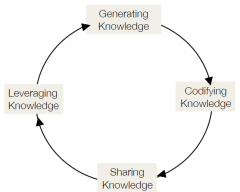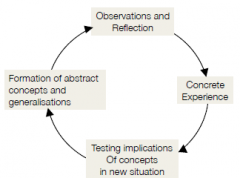![]()
![]()
![]()
Use LEFT and RIGHT arrow keys to navigate between flashcards;
Use UP and DOWN arrow keys to flip the card;
H to show hint;
A reads text to speech;
29 Cards in this Set
- Front
- Back
|
What is knowledge management? |
Knowledge Management: Efficient handling of information and resources within an organization. |
|
|
Briefly describe tacit and explicit knowledge. |
Tacit knowledge is the kind of knowledge that is difficult to transfer to another person by means of writing down or verbalizing.
Explicit knowledge is the type of knowledge that can be readily transmitted to others as it has been stored in some way. Good examples of this are textbooks or encyclopedias. |
|
|
How can tacit knowledge be converted to explicit knowledge? |
Externalization is the process that transforms tacit knowledge into explicit form. This can be done using collaboration systems, online discussion database, wikis, blogs, forums. The process requires transforming the knowledge that is minds of people, into electronic forms. |
|
|
How can explicit knowledge be converted to tacit knowledge? |
Internalization is sharing and distribution of knowledge within the organization, using online learning/e-learning, intranet portals, knowledge repository searching and data mining. |
|
|
What is single loop learning? How does double loop learning differ? |
Single Loop Learning works on improving existing systems that rest on unchallenged assumptions. This solves problems, but doesn't address the underlying cause of the problems.
Double Loop Learning expands the analytical frame to explicitly identify and then challenge the underlying assumptions. |
|
|
Explain the difference between data, information and knowledge. |
Data: Facts and figures which relay something specific, but are not organized in any way.
Information: Contextualized, categorized, calculated and condensed data. Data with meaning applied.
Knowledge: Know-how, understanding, experience, insight, intuition and contextualized information. |
|
|
List the four stages of the knowledge management life cycle. |

Generating Knowledge
Codifying Knowledge
Sharing Knowledge
Leveraging Knowledge |
|
|
Describe the following processes:
i. Socialisation ii. Internalisation iii. Externalisation iv. Combination |
i. Socialisation; Tacit to tacit. Shared experience and interaction. ii. Internalisation; Explicit to tacit, through the learning process. iii. Externalisation; Tacit to explicit, through using metaphors and figurative language. iv. Combination; Explicit to explicit, through reconfiguring existing knowledge. |
|
|
What is meant by the term data warehouse? |
A data warehouse is a large store of data accumulated from a wide range of sources within a company and used to guide decisions. |
|
|
What is meant by data mining and how is this useful to knowledge management? |
Data mining is the practice of examining large pre-existing databases in order to generate new information. Within Knowledge Management, this allows recognition of patterns to predict future trends and plan/act accordingly. |
|
|
Briefly describe the four main stages of the knowledge management life cycle. |
Generating Knowledge: Knowledge acquired by an organisation as well as that created by it. Codifying Knowledge: Put organisational knowledge into a form that Sharing Knowledge: Sharing relevant knowledge across the organisation. Leveraging Knowledge: Ensuring that the acquired knowledge is utilized, put to appropriate use etc. |
|
|
What is meant by Case Based Reasoning (CBR)? |
Case Based Reasoning is the process of solving new problems based on the solutions of similar past problems. An auto mechanic who fixes an engine by recalling another car that exhibited similar symptoms is using case-based reasoning. |
|
|
What is meant by the term Knowledge Map? |
A Knowledge Map is used to help locate a "knower". It is created as a guide, not a repository, in order to point someone towards a person who possesses certain knowledge and is especially useful when it comes to tacit knowledge. |
|
|
What is meant by a Community of Practice (CoP)? |
A CoP is a group of people who share a concern, set or problems or passion about a topic, and who deepen their knowledge and their expertise in this area by interacting on an ongoing basis.
Learning conducted in this method is not always intentional. |
|
|
What is the purpose of a Chief Knowledge Officer (CKO)? |
A CKO is an organizational leader, responsible for ensuring that the organization maximizes the value it achieves through "knowledge". The CKO is responsible for managing intellectual capital and the custodian of Knowledge Management practices in an organization. |
|
|
What is meant by the term Business Rules? |
A business rule is a statement that defines or
Example: Anyone placing an order with us is a customer. |
|
|
There are three types of business rule. What are they? Briefly describe each. |
Structural Business Rules; statements about the data objects that an organisation's business deals with. Behavioural Business Rules; statements about some dynamic aspects of a business. Constraint Business Rules; statements about the conditions under which an organisation's business operates. |
|
|
What is an ontology? How is it useful? |
An ontology compartmentalizes the variables needed for some set of computations and establishes the relationships between them. |
|
|
What are the three types of data?
Describe them briefly. |
Big Data; data that cannot be handled with conventional tools (or a term used as a vague metaphor for solving problems with data). Open Data; data anyone can use without legal, technical or financial barriers. Personal Data; derived from people, where you can distinguish a person from others in a group. |
|
|
What is the Internet of Things (IoT)? |
The IoT is the interconnection of uniquely identifiable embedded computing devices within the existing Internet infrastructure. |
|
|
What are the two types of Information Organisation Schemes? |
Exact Organisation Schemes Well defined, mutually exclusive categories. e.g. Phonebook
Inexact Organisation Schemes Ill-defined, overlapping categories. e.g. Yellow Pages |
|
|
Give three examples of an Exact Organisation Scheme. |
Alphabetical
Geographical
Chronological |
|
|
Give three examples of an Inexact Organisation Scheme. |
Topical
Task-based
User-specific |
|
|
What is meant by XML and how is it used? |
XML; extensible markup language.
XML is an information representation language which helps to emphasize meaning behind stored information using appropriate HTML styled tags. |
|
|
What are the stages of Individual Learning? |

i. Observations and Reflection ii. Concrete Experience iii. Testing implications of concepts in new situation iv. Formation of abstract concepts and generalisations |
|
|
What are the two modes of group learning? Describe them. |
i. Divergent Thinking is a thought process or method used to generate creative ideas by exploring many possible solutions.
ii. Convergent Thinking is the type of thinking that focuses on coming up with the single, well-established answer to a problem. |
|
|
What is organisational learning? |
Organisational learning is the process of creating, retaining, and transferring knowledge within an organisation. An organisation improves over time as it gains experience. From this experience, it is able to create knowledge. |
|
|
What is a DTD and why is it used? |
DTD; document type definitions.
A DTD essentially defines grammar rules for XML documents. |
|
|
What is the difference between a well-formed and valid XML document? |
A syntactically-correct XML document is said to be well-formed.
|

